Environmental Mainstreaming in Mine Action: A Case Study of Moving Beyond “Do No Harm”
Emily Chrystie [ The HALO Trust ]
CISR Journal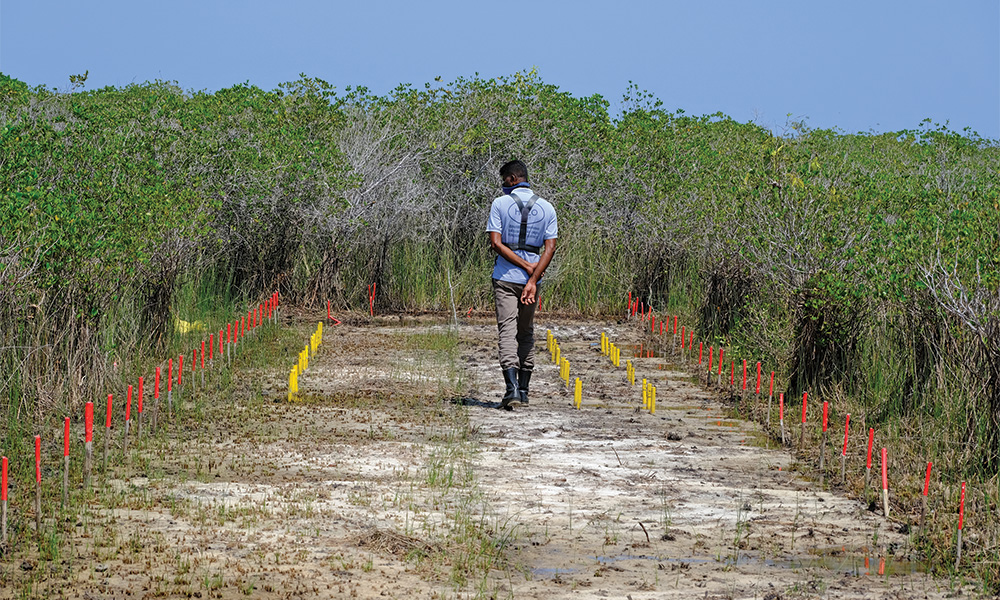
This article is brought to you by the Center for International Stabilization and Recovery (CISR) from issue 27.2 of The Journal of Conventional Weapons Destruction available on the JMU Scholarly Commons and Issuu.com
Interest within the mine action sector in mainstreaming environmental issues has rocketed in the past few years. The establishment of cross-sector working groups, the investigatory work of organizations such as the Conflict and Environment Observatory (CEOBS), and increased donor interest in directing funds toward environmental projects are arguably the result of broad scientific consensus on the increasingly destructive effects of anthropogenic forces on global ecosystems.
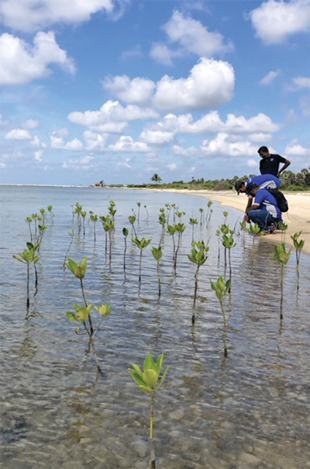
The well-established concept of do no harm1 is a framework commonly applied in the broader humanitarian sector and has been put forward as directly applicable to environmental concerns within mine action.2 The concept broadly reflects current approaches of mine action organizations to mitigate and minimize direct (negative) environmental impacts of mine clearance operations. This is reflected in the current International Mine Action Standards (IMAS) on Environmental Management3 (under review), with its focus on avoiding environmental harm through the direct impacts of mine action activities, including through emissions, erosion, residual waste, and harm to wildlife and vegetation.
This article posits that, while the do no harm approach remains well suited to mitigation of direct impacts of mine action activities and should continue to be applied, it is necessary to understand it as a single component within a broader framework to take full advantage of the potential for environmental mainstreaming within mine action.
WARFARE ECOLOGY
The Warfare Ecology4,5 field of study, put forward in 2008 to address the fragmented nature of environmental research into ecological change caused by human conflict, encapsulates both natural and social (human) impacts of conflict and their reverberations over time. The approach facilitates a holistic understanding of the impacts (both positive and negative) of conflict on ecosystems and ecosystem services6 by structuring potential impacts into a broader taxonomy. This taxonomy accounts for three distinct stages of conflict: preparations, war, and post-war activities. Each stage is understood to have corresponding impacts observable at different scales: landscape, regional, and global. Mine action activities, commonly found at the time of post-war and scale of landscape, can be understood as one product of a complex system which is inextricably linked with the ecological consequences of the entire lifecycle of war.
The growing literature on warfare ecology has seen the concept applied to environmental analyses of multiple conflicts around the world7,8,9,10,11 and reflects a growing trend of viewing social and natural impacts of conflict as being inseparable from the broader lifecycle of war.
As noted by Ian McLean in his feature on environmental applications in demining, the ecological consequences of human absence due to contamination with explosive hazards are not necessarily negative in terms of impacts on local biodiversity.12 Conflict-related area denial, in which human presence is limited due to the effects of conflict (whether through contamination by explosive ordnance (EO) or other factors), can relieve human pressures on struggling ecosystems. While the intent of such area denial may be conflict related, the effect can be reminiscent of fortress conservation, a term that is broadly understood as the forceful eviction of peoples from land in the name of conservation.
However, legal and moral imperatives aside, the focus of environmentalism in a post-conflict setting has long since moved on from the de facto fortress conservationism13 that can in some contexts be provided by conflict-related large-scale area denial.14 Rather, the focus has moved to ensuring sustainable reintegration of human communities into a functioning ecosystem.15
CASE STUDY: MANGROVE RESTORATION IN SRI LANKA
To demonstrate the relevance of a warfare ecology approach to environmental mainstreaming in mine action, an example is taken from The HALO Trust’s (HALO) work in Sri Lanka. In 2021, HALO sought funding for an environmental restoration project that would see 4,000 mangrove saplings planted in previously mined lagoon and coastal areas of the Jaffna Peninsula. Considered Sri Lanka’s dry zone, this fragile ecosystem has come under increased ecological pressure due to the combined effects of the reverberating impact of conflict, and changes to weather patterns and sea levels resulting from climatic changes. The largest minefield on the peninsula, Muhumalai, saw dense minelaying activities by both the Sri Lankan Army and the Liberation Tigers of Tamil Elam (LTTE) for over a decade until the culmination of the war in 2009.
“We were [always] catching prawns under the roots of mangroves on our beach. We then cooked the prawns and enjoyed eating them on the beach too. Those mangrove forests were totally destroyed by the war.”
~Sixty-five-year-old participant of community orientation session, Jaffna Peninsula
As contaminated land on the peninsula is cleared of explosive hazards and families return to their pre-war lands, the reverberating effects of conflict continue to affect local livelihoods. A key problem in the Northern Province is that of changes to soil salinity levels, leading to abandonment of previously fertile paddy lands that can no longer support rice crops.16 Salt-water intrusion—the migration of seawater onto landmasses—is a key driver of soil salination in the region. Studies of salinity changes in agricultural wells on the peninsula from 1999–2020 found groundwater salinity to have increased by 1.6-fold over that period,17 with increased groundwater salination affecting 45 percent of the peninsula.18 Leading to the over-salination of previously fertile paddy fields, the problem of saltwater intrusion has been exacerbated by sea level rises in the region, as well as through the destruction of coastal mangrove systems and man-made bunds and barrages designed to mitigate saltwater intrusion during the period of conflict.
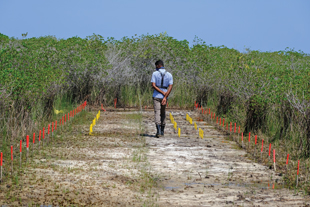
Coastal vegetation, an effective, low-cost bio-shield that can mitigate the occurrence of salt-water intrusion on the peninsula through dissipation of storm surges and prevention of erosion,19 has been further depleted by ongoing mine clearance activities, the safe clearance of complex mine-lines necessitating removal of significant areas of vegetation.
“Conservation is not our area of expertise, but partnering with local environmental experts helped us to understand where we could direct our own resources in support of this project. Facilitating HDO to take ownership of the project precipitated local engagement, and has bought in local researchers and other stakeholders who are passionate about long-term restoration of the mangrove ecosystem.”
~Iris Frakking, HALO Sri Lanka
Applying a do no harm model in the Sri Lankan context requires mitigation of further damage to coastal ecosystems that may be caused by mine clearance activities, and restoration of any areas damaged through, for example, the essential use of mechanical clearance techniques. HALO’s environmental project goes a step further here, however, by applying a broader understanding of the impacts of decades of EO contamination and addressing the reverberating effects of the conflict itself that continue to preclude livelihoods restoration for the beneficiaries of mine clearance activities. This was achieved by centering restoration efforts on an understanding of the pre-war ecosystem, rather than on pre-clearance ground conditions and flora.
The problems identified previously were recognized organically throughout HALO’s long-standing work on the ground in Sri Lanka. In the future, as pre-clearance environmental assessments become the norm across the mine action sector, it is predicted that issues such as these will increasingly be recognized early in the land release process, facilitating donor engagement and identification of local partners and environmental experts.
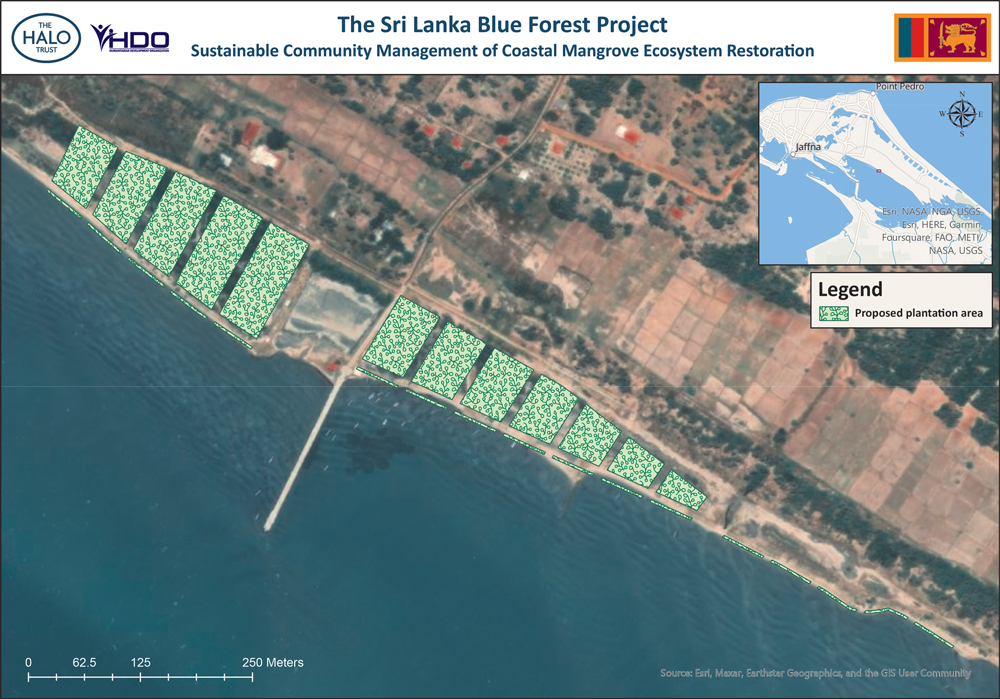
PROJECT SUMMARY
The project itself was initially proposed with this broader context in mind: to address the cumulative impact of EO contamination from every stage of the conflict lifecycle. In practice, this meant targeting restoration efforts not only in areas affected by mine clearance operations, but also in areas that were already free from vegetation at the time of clearance due to war-time damages.
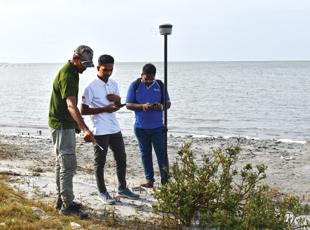
The project was initiated on the ground in June 2022, and is due for completion by June 2023. Through HALO’s partnership with a local NGO, Humanitarian Development Organisation (HDO), a local ecologist with expertise in mangrove conservation was contracted to assess the suitability of proposed project sites. Three mangrove conservation experts, two of whom visited the project site in person, independently reviewed the resultant report. HALO’s own geographic information system (GIS) teams assisted in accurate mapping of proposed sites, and HALO’s non-technical survey (NTS) teams, benefiting from longstanding relationships with local communities, assisted in conducting stakeholder meetings to gather input from local fishermen, nearby landowners, and government officials.
HALO and HDO have since run four village-level community orientation meetings and involved local grassroots organizations including the Rural Development Society, Fisheries Society, and local youth clubs and religious committees. These meetings saw a collaboration between HALO, who delivered explosive ordnance risk education (EORE), and HDO who delivered environmental awareness sessions.
PROJECT OUTCOMES
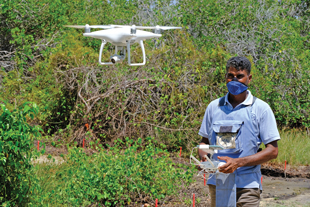
To date, the project has seen 3,000 mangroves planted in a 6,000 sqm area, with 1,000 additional trees to be planted before the end of 2023. The long-term impact of this project on the local ecosystem and communities who rely on it will take longer to establish.
However, the model of using expert mine action personnel with different focuses—GIS, community liaison, and survey, alongside partnerships with local NGOs and environmental experts to facilitate long-term local ownership—is one that would benefit from further research and wider application in the sector.
CONCLUSION
The impacts on livelihoods caused by conflict and mine laying activities go beyond the very real risk to life and limbs posed by EO contamination. When viewed through the broader framework of warfare ecology, the applicability of projects such as the one described in this article to the core work of mine clearance organizations can be better understood. In Sri Lanka, the dense contamination of coastal areas by landmines and UXO has not only taken an enormous human toll, but has also directly exacerbated further ecosystem degradation through years of access denial that precluded replanting of coastal mangroves and rebuilding of protective bunds and barrages, further impacting post-conflict livelihoods restoration. Taking the definition of mine action as “activities which aim to reduce the social, economic and environmental impact of mines, and ERW…,”20 it is therefore suggested that engaging with ecological damages caused at all stages of EO contamination—pre-, during, and post-conflict—is not beyond the core remit of mine action organizations.
Emily Chrystie
Research and Development Officer
The HALO Trust
 Emily Chrystie is a Research and Development Officer at The HALO Trust. She specializes in developing operational safety, efficiency, and effectiveness and has worked in operational roles in fifteen mine-affected countries globally. Chrystie holds an MSc in Defence, Development, and Diplomacy from Durham University.
Emily Chrystie is a Research and Development Officer at The HALO Trust. She specializes in developing operational safety, efficiency, and effectiveness and has worked in operational roles in fifteen mine-affected countries globally. Chrystie holds an MSc in Defence, Development, and Diplomacy from Durham University.
| Stay updated | |||
